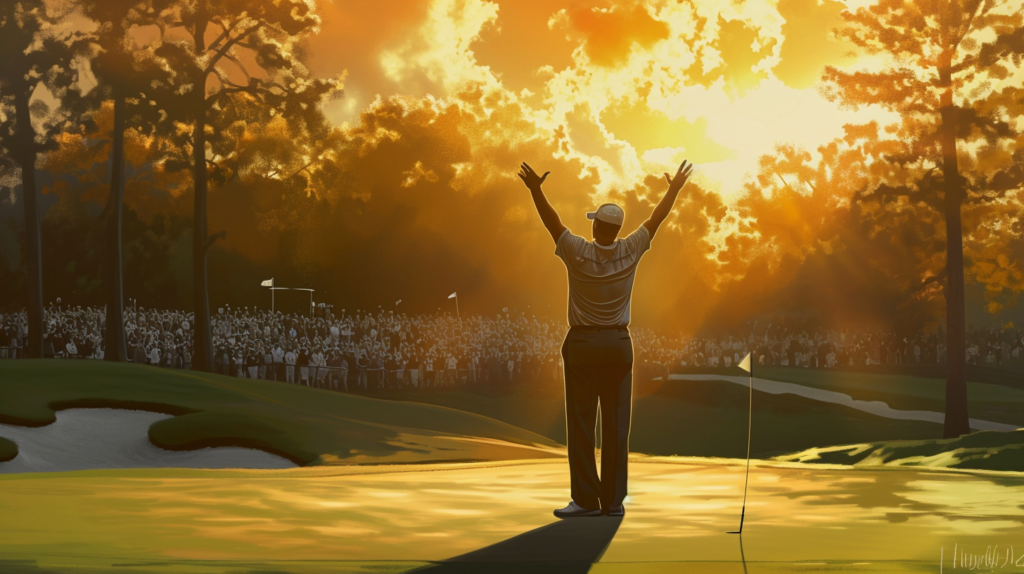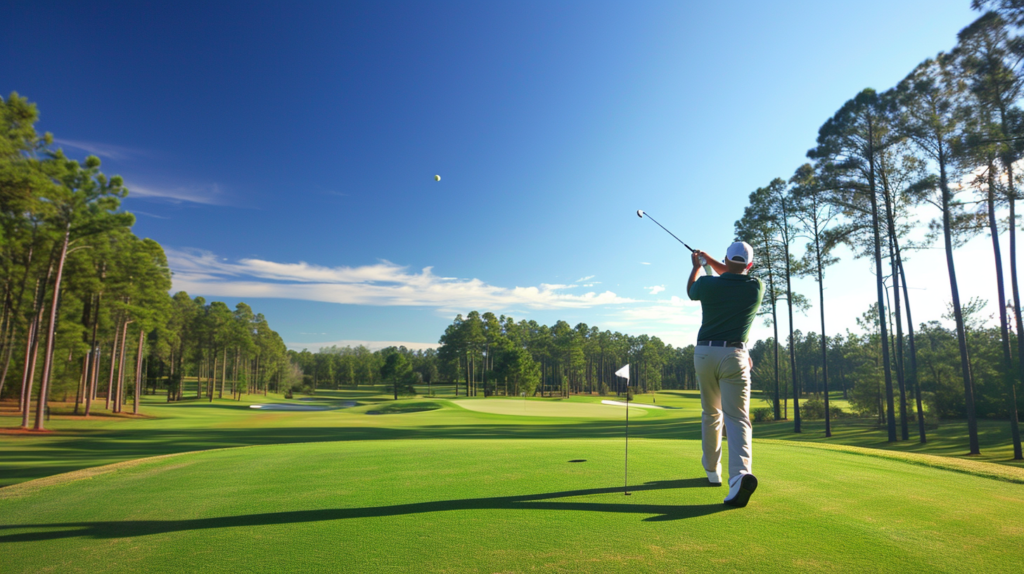In golf, spectacularly reaching a par 5 hole in only two shots leads to the exhilarating achievement of an eagle. But what exactly constitutes this rare gem of scoring on the scorecard?
An eagle in golf occurs when a player scores two under par on a single hole, demonstrating the ideal blending of power, accuracy and touch required in the sport.
Let’s dive into the specifics of how to score an eagle, why they matter so much, and some of the most famous examples in major championship history
Definition Of An Eagle In Golf

In the game of golf, an eagle refers to scoring two under par on a single hole. For example, if a par 5 hole has a par rating of 5 strokes, then scoring a 3 would be considered making an eagle.
It demonstrates excellent golf skills and shot-making capabilities over the course of the hole.
Specifically, an eagle occurs when a player is able to reach a par 5 hole in two shots or fewer during regulation play.
They drive the ball with immense distance and accuracy off the tee, position their second shot perfectly onto the putting green, then sink the long, difficult putt for a 3. This showcases great precision and performance tofinish two strokes under expectation in a single hole effort.
Comparatively in scoring, an eagle ranks higher than the more common hole accomplishment, the birdie, which refers to scoring one under par.
However, an eagle scores lower than the rarest hole achievement in golf – the albatross – which happens when a player scores three under par on a single hole. But the eagle represents a special combinationof skills to pull off, blending both power and touch.
Eagles typically happen on lengthy par 5 holes that stretch over 500 yards from tee to green, requiring perfectly distanced and positioned shots to reach in the requisite two strokes.
Players first must drive the ball over 300 yards into the fairway to set up an approach under 200 yards to the green in hopes of the subsequent putt finding the hole for eagle.
Significance Of An Eagle

In tournament golf and professional events, eagles carry great significance for players looking to go low and separate from the field.
Scoring an eagle demonstrates immense skill to reach a par 5 green in only two shots when the hole is designed for it to normally take three or more strokes.
Eagles are exclusively possible on par-5 holes, which make up the minority length holes on any golf course. Players may see only two to three legitimate eagle chances per 18-hole round based on the course design.
As such, when a golfer converts one of those infrequent chances for eagle, it brings excitement and momentum.
The rarity of eagles compared to routine pars, bogeys and birdies is why it is considered such an exceptional achievement. By nature of course layouts, reaching par-5 greens in two shots requires almost perfectly executed drives and approach shots.
The green complexes also require deft putting skill to convert the long, downhill eagle putts.
Seeing their favorite golfer score an eagle elicits loud cheers and applause from attending fans, especially during major championships. Similarly, players exhibit pure joy and celebration with fist pumps, club twirls and handshakes with their caddies.
Eagles can propel runs of even lower scores.
For viewers, broadcasters and golf media, eagles also spark extra discussion and attention on the player’s outstanding execution. Replays of the massive drives and pinpoint approach shots showcase the combo of power, accuracy and deft short game skill required.
Eagles essentially certify masters of the sport.
Tips For Scoring An Eagle

Golfers looking to add more eagles into their scorecards can work on a combination of skills and strategies to set up more scoring chances:
Powerful and Accurate Drives
The foundation of every eagle attempt begins with the drive off the tee. On long par-5 holes of over 500 yards, players need to launch drives carrying over 300 yards to have a chance at reaching the green in two shots.
Consistently hitting tee shots deep into the fairway over 325 yards makes eagles possible. Elite ball-strikers like Rory McIlroy routinely drive the ball over 350 yards, which opens up eagles on nearly every long par-5.
In addition to extraordinary distance, drives need to find the fairway and offer a clear path towards the green. Crushing big drives into the rough or trees immediately lessens the odds to reach par-5 greens in two shots.
Golfers wanting eagles have to blend immense power with sound accuracy.
Flawless Long Iron or Fairway Wood Approach Shots
After the drive, golfers need to perfectly strike their second shot onto the putting green, whether with a long iron, fairway wood or hybrid. The approach needs to fly high and land soft to hold the firm greens.
From 200-250 yards out, players have to judge distance control, account for hazards near the greens and allow for release upon landing.
Sticking an approach shot within 15-20 feet proximity to the hole at least gives a chance to make the subsequent winding eagle putt attempt. Consistently within 10 feet further increases odds to convert.
Being deft with accurate long-range approach shots are instrumental for golfers to have eagle looks.
Reading Eagle Putts
Perhaps the most underrated skill necessary for eagles is being able to read extremely long, downhill putts that twist and turn towards the hole after shots reach the green in two strokes. Eagle putts range from 20-50 feet in length with subtle breaks that are difficult to decipher.
The speed and line have to be judged perfectly on putts that could run 10-15 feet past if mishit. Confidence making putts outside 25 feet gives players a better chance to capitalize on great approach shots.
Taking Strategic Risks
Certain par-5 holes lend themselves to eagles more than others based on their design and layout. Some longer holes have creek beds, ponds and water hazards to carry over second shots.
Aggressively taking on heroic shots over Corner hazards or narrowly cutting doglegs offers potential rewards of eagles. Accounting for risk-reward scenarios and strategically trying to reach greens in two, even if low-percentage shots, can pay off for players willing to gamble.
Capitalizing on Downwind Holes
Weather conditions impact eagles chances as well. On par-5 holes downwind, players can maximize extra distance on their drives and second shots.
Taking advantage of downwind holes to reach greens more easily set up more eagle looks, compared to having to hit shots much longer into headwinds. Seizing downwind fortunes when they happen allows players to score more eagles.
Famous Tournament Eagles

Throughout major championship history and professional golf events, there have been many renowned eagles scored at pivotal moments:
Tiger Woods’ 2005 Masters Chip In Eagle
At the par-3 16th hole in the final round of the 2005 Masters, Tiger Woods famously missed his tee shot long and wide left of the green. Faced with an impossibly fast greenside lie, Tiger elected to putt the ball up the slope rather than chip.
He struck the ball perfectly up the hill and it trickled downhill towards the cup, eventually finding the hole for a miraculous eagle two on his way to a fourth green jacket. It remains iconic as the “In Your Life!” chip.
Jack Nicklaus Augusta National Career “Eagle Slam”
Legendary golfer Jack Nicklaus accomplished a unique career achievement by scoring eagles on all four of Augusta National’s par-5 holes in the same round at the 1995 Masters.
He reached the long 13th and 15th holes in two, then eagled the easier 2nd and 8th holes with perfectly measured putts. Nicklaus showed off the power and precision touch that made him the most prolific eagle scorer ever at the Masters tournament with 24 total.
Rory McIlroy 2014 Open Championship Eagle
On his runaway victory march at Royal Liverpool in 2014, Rory McIlroy stamped his first ever Claret Jug with a number of signature moments. One was holing out from the greenside bunker on the par-5 10th hole in two shots to score an improbable eagle.
It demoralized the chasers and fortified McIlroy’s six-shot margin at the time late on Sunday. He stretched his lead to win by two shots for his 3rd major title.
Jason Day Long Range Eagle Putt at 2017 PGA Championship
During Quail Hollow’s hosting of the 2017 PGA Championship, fan favorite Jason Day electrified the crowd when he reached the signature 7th hole in two shots.
After finding the front portion of the huge green with his approach, Day still faced a daunting 25-foot eagle attempt. Unfazed, he perfectly judged the uphill breaking putt that found the cup to roars and extended his lead.
While he eventually finished 9th, the long range eagle epitomized Day’s world class talent.
The excitement that comes from golf’s outstanding players executing clutch eagles on the biggest stages keeps fans glued to the action.
Whether Tiger’s magic chip-in or Rory brazenly reaching a par-5 in two, eagles frequently deliver indelible moments that shape tournament outcomes. The blend of length, accuracy and touch required to pull them off certify the sport’s elite competitors.
Conclusion
Scoring an eagle in golf is a unique achievement that combines power, accuracy, and finesse. By mastering drives over 300 yards, precise long iron shots, and winding uphill putts, the world’s best players set themselves up for the big momentum swing of eagles.
When executed on the biggest stages, eagles like Tiger’s improbable chip-in make major championship history. For any golfer, the rarified feeling of reaching a par 5 in two shots and watching the eagle putt drop is one of the most thrilling accomplishments the game offers.



